List of Pomeranian duchies and dukes
This is a list of the duchies and dukes of Pomerania.
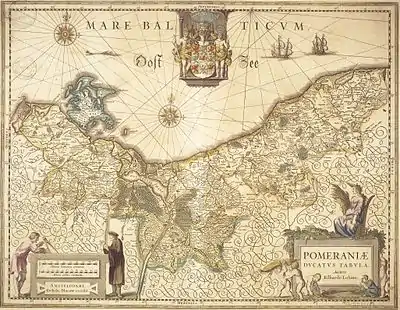
Dukes of the Slavic Pomeranian tribes (All Pomerania)
The lands of Pomerania were firstly ruled by local tribes, who settled in Pomerania around the 10th and 11th centuries.
Non-dynastic
| Ruler | Born | Reign | Death | Ruling part | Consort | Notes | |
|---|---|---|---|---|---|---|---|
| Siemomysł | c.1000 or 1020 | After 1000–1046 | c.29 June 1046 | All Pomerania | Unknown | First known duke of all Pomerania. His origins are unknown. | |
| Świętobor | before 1046 | 1060–1106 | 1106 | All Pomerania | Anna | Son of Siemomysl. | |
| Świętopełk I | before 1106 | 1106–1113 | 1113 | Gdańsk Pomerania (future Pomerelia) | Unknown | ||
In 1106, Pomerania is divided by his two older sons: Wartislaw, who founded the House of Pomerania and the Duchy of Pomerania, and Świętopełk I. After Swietopelk's death, his lands were occupied by the Saxon prince Lothar of Supplinburg. In 1155, the lands regained independence under Sobieslaw I, who founded the dynasty of the Samborides, and the Duchy of Pomerelia.
Duchy of Pomerania
The Duchy resulted from the partition of Świętobor, Duke of Pomerania, in which his son Wartislaw inherited the lands that would become in fact known as Pomerania.

First partition 1155–1264
In 1155, Pomerania was divided in Pomerania-Szczecin and Pomerania-Demmin. In the struggle to shake off Polish and Danish claims to feudal overlordship, Pomerania approached the Holy Roman Empire. In 1181, while staying in the camp outside the walls of Lübeck, Emperor Frederick I Barbarossa recognised Bogislaw I as duke of S(c)lavia, as it was called in the document.[1] However, three years later in the Battle in the Bay of Greifswald (1184) the Danish Canute VI forced Pomerania to accept him as liege lord.[2] In 1190 the Land of Słupsk-Sławno separated itself from Szczecin. With the defeat of Denmark in the Battle of Bornhöved (1227) Pomerania shook off the Danish liege-lordship,[3] except for the city of Szczecin which remained under Danish suzerainty until 1235.
In 1231 Emperor Frederick II granted the immediate liege lordship over Pomerania to the Margrave of Brandenburg, who enforced this claim by the Treaties of Kremmen (1236) and of Landin (1250). Thus Pomerania had become a fief of Brandenburg, thus an only mediate (indirect) subfief of the Empire, with Brandenburg itself being an immediate imperial fief.
In 1227, Słupsk came to Eastern Pomerania (Pomerelia) within fragmented Poland, Sławno to Western Pomerania. In 1238 both became part of Pomerelia, ruled by the House of Sobiesław, and following the extinction of the line in 1294, both were directly reintegrated with Poland in accordance with the Treaty of Kępno. In 1317, the area became part of the Pomerania-Wolgast (Wołogoszcz), first as a pawn from Brandenburg, and definitively in 1347.
After Wartislaw III died heirless in 1264, Barnim I became sole duke of the whole duchy. After Barnim's death, the duchy was to be ruled by his sons Barnim II, Otto I and Bogislaw IV. The first years, Bogislaw, being the eldest, ruled in place of his too young brothers.
Second partition 1295–1368
In 1295, the Duchy of Pomerania was divided roughly by the Peene and Ina rivers, with the areas north of these rivers ruled by Bogislaw IV became Pomerania-Wolgast, whereas Otto I received Pomerania-Szczecin south of these rivers.
Third partition 1368–1376
In 1368, Pomerania-Wolgast was divided into a western part (German: Wolgast diesseits der Swine, including the name-giving residence in Wolgast) and an eastern part (German: Wolgast jenseits der Swine, in literature also called Pomerania-Stolp or Duchy of Słupsk after the residence in Słupsk (Stolp)), which came back under Polish suzerainty as a fief.
Fourth partition 1376/1377–1478 and Pomeranian immediacy
In 1376, the western part of Pomerania-Wolgast (German: Wolgast diesseits der Swine) was subdivided in a smaller western part sometimes named Pomerania-Barth (Bardo) after the residence in Barth, and an eastern part which included the residence in Wolgast. In the following year, the Duchy of Słupsk was divided into a western part which included Stargard and an eastern part which included the residence in Słupsk (Stolp).
In 1459, the eastern partitions of Pomerania-Wolgast around Stargard and Stolp ceased to exist. In 1478, after 200 years of partition, the duchy was reunited for a short period when all her parts were inherited by Bogislaw X. By the Treaty of Pyritz in 1493 Pomerania shook off the Marcher liege lordship and became again an immediate imperial estate, after new disputes finally confirmed by the Treaty of Grimnitz in 1529, both treaties provided Brandenburg succession in case the Pomeranian dukes would become extinct in the male line.
Fifth and sixth partitions 1531–1625
In 1531, Pomerania was partitioned into Pomerania-Stettin (Szczecin) and Pomerania-Wolgast. This time however, in contrast to the earlier partitions with the same names, Pomerania-Wolgast included the western, and Pomerania-Stettin the eastern parts of the duchy. In 1569, were created the duchies of -Barth (split off from -Wolgast) and -Rügenwalde (Darłowo) (split off from -Stettin).
Definitive reunification and annexation to Sweden
In 1625, Bogislaw XIV reunited all Pomerania under his rule. However, in 1637, Sweden hold western parts of Pomerania (Hither Pomerania), originally including Stettin, legalised by the Peace of Westphalia in 1648 (Swedish Pomerania, several times reduced in favour of Brandenburgian Pomerania). Between 1637 and 1657 Lauenburg-Bütow Land (Lębork and Bytów) were reintegrated directly to Poland as a reverted fief, thereafter passed to Brandenburg under Polish overlordship until the Partitions of Poland. In 1648, Brandenburg prevailed in the Peace of Westphalia with its claim only for eastern parts of Pomerania (Farther Pomerania), with the Brandenburg electors officially holding simultaneously the title of dukes of Pomerania until 1806 (end of the Empire and its enfeoffments), but de facto integrating their Pomerania into Brandenburg-Prussia, making it one of the provinces of Prussia in 1815, then including former Swedish Pomerania.
Partitions of Pomerania under Griffins rule
| Duchy of Pomerania (1st creation) (1121–1156) | |||||||||||
| Demmin (1st creation) (1156–1184) |
Szczecin/Stettin (1st creation) (1156–1264) |
Sławno-Słupsk/Schlawe-Stolp (1156–1238) | |||||||||
| Demmin (2nd creation) (1208–1264) |
|||||||||||
| Duchy of Pomerania (2nd creation) (1264–1295) | |||||||||||
| Szczecin/Stettin (2nd creation) (1295–1464) | |||||||||||
| Barth (1st creation) (1377–1393) |
Wolgast (1st creation) (1295–1478) |
Słupsk/Stolp (1368–1459) |
Stargard (1377-1395) | ||||||||
| Barth (2nd creation) (1425–1451) |
|||||||||||
| Barth (3rd creation) (1457–1478) |
|||||||||||
| Duchy of Pomerania (3rd creation) (1478–1531) | |||||||||||
| Wolgast (2nd creation) (1531–1625) |
Szczecin/Stettin (3rd creation) (1531–1569) | ||||||||||
| Barth (4th creation) (1569–1603) |
Darłowo/ Rügenwalde (1st creation) (1569–1600) |
(Wolgast line 1569–1600) | |||||||||
| (Rügenwalde line 1600–1603) | |||||||||||
| (Barth line 1603–1625) | Darłowo/ Rügenwalde (2nd creation) (1603–1620) | ||||||||||
| Duchy of Pomerania (4th creation) (1625–1637) | |||||||||||
Table of rulers
(Note: Here the numbering of the dukes is the same for all duchies, as all were titled Dukes of Pomerania, despite the different parts of land or particular numbering of the rulers. The dukes are numbered by the year of their succession.)
| Ruler | Born | Reign | Death | Ruling part | Consort | Notes | |
|---|---|---|---|---|---|---|---|
| Warcislaus I |  | c.1091 | 1121–1135 | 1135 | Pomerania | 24 pagan wives Heila of Saxony before 1128 one child Ida of Denmark 1129 three children | First duke of Pomerania and founder of the family as a vassal of Poland. A pagan, he converted to Christianity in the beginning of the 12th century. Then, along with his son Bolesław, backed Otto of Bamberg in his successful Conversion of Pomerania. |
| Racibor I |  | c.1124 | 1135–1156 | 1156 | Pomerania | Pribislava Yaroslavna of Volhynia 1136 four children | Ancestor of the Ratiboriden branch of the House of Pomerania that ruled Słupsk-Sławno |
| Casimir I | 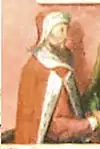 | after 1130 | 1156–1180 | fall of 1180 | Pomerania-Demmin | Pritolawa no children | |
| Swietopelk | Before 1156 | 1156–c.1190 | 1190s | Pomerania-Schlawe-Stolp | Unmarried | ||
| Bogislaw I |  | 1127 | 1156-1184 | 18 March 1187 | Pomerania-Stettin | Walburga of Denmark three children Anastasia of Greater Poland 26 April 1177 two children | In 1184 after the death of his nephew Warcislaus II, reunited Stettin and Demmin. |
| Warcislaus II | c.1160 | 1180–1184 | c.1184 | Pomerania-Demmin | Sophia of Poland no children | ||
| Regency of Anastasia of Greater Poland (1187-1208) | Children of Bogislaw I, they split once more the duchy between them. | ||||||
| Bogislaw II |  | 1177 | 1187–1220 | 23 January 1220 | Pomerania-Stettin | Miroslava of Pomerelia 1210 three children | |
| Dobroslawa | c.1175? | 1187–1220 | c.1220 | Pomerania-Stettin (at Schlawe and Gützkow) | Wartislaw, castellan of Stettin c.1200 one child | ||
| Casimir II |  | c.1180 | 1187–1219 | 1219 | Pomerania-Demmin | Ingard of Denmark 1210 two children | |
| Bogislaw III |  | before 1190 | c.1190–1223 | 1223 | Pomerania-Schlawe-Stolp | A daughter of Mieszko III of Poland before 1223 two children | Son of Bogislaw II and younger brother of Barnim I. His existence is not certain. Received the -Sławno part in 1190 by his father. |
| Regency of Ingard of Denmark (1219-1226) | After his death in 1264, Barnim became the sole duke. | ||||||
| Warcislaus III |  | c.1210 | 1219–1264 | 17 May 1264 | Pomerania-Demmin | Sophia 1236 three children | |
| Racibor II | before 1223 | 1223–1238 | 1238 | Pomerania-Schlawe-Stolp | unmarried | Son of Bogislaw III. Other historians suggest that he could be also son of Bogislaw II or Mestwin I of Pomerelia. After his death without descendants, the land returned to Pomerania. | |
| Regency of Miroslava of Pomerelia (1220-1226) | Since 1227 the dukes were again vassals of the Holy Roman Empire. In 1264 Barnim reunited all Pomerania. | ||||||
| Barnim I the Good |  |
c.1217/1219 | 1220–1264 | 13 December 1278 | Pomerania-Stettin | Anna Maria of Saxony between 4 September 1238 and 18 July 1242 three children Margaret of Brunswick-Lüneburg 1252 or 1253 one child Matilda of Brandenburg between 29 March 1263 and 20 May 1267 six children | |
| 1264-1278 | Pomerania | ||||||
| Bogislaw IV | 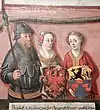 |
c.1255 | 1278–1295 | 19/24 February 1309 | Pomerania | Matilda of Brandenburg-Stendal between 1275 and 1278 no children Margaret of Rügen 13 August 1284 six children |
Ruled jointly. Bogislaw was the eldest son of Barnim I, and ruled with his stepmother, who was regent of her own sons. From 1294 Bogislaw ruled directly with his half-brothers Barnim and Otto, who reached majority in that year. Following the death of Barnim without descendants in 1295, Bogislaw and Otto divided Pomerania between them: Bogislaw retained Wolgast and Otto received Stettin. |
| 1295-1309 | Pomerania-Wolgast | ||||||
| Regency of Matilda of Brandenburg, co-ruling with Bogislaw IV (1278-1294) | |||||||
| Barnim II | 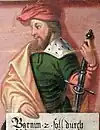 | c.1277 | 1278-1295 | 28 May 1295 | Pomerania | Unmarried | |
| Otto I |  |
1279 | 1278–1295 | 31 December 1344 | Pomerania | Elisabeth of Holstein April 1296 two children | |
| 1295–1344 | Pomerania-Stettin | ||||||
| Warcislaus IV | 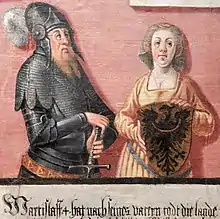 | before 1290 | 1309–1326 | 1 August 1326 | Pomerania-Wolgast | Elisabeth of Lindow-Ruppin 11 April 1316 or 1317 three children | Son of Bogislaw IV. |
| Barnim III the Great |  | c.1300 | 1344–1368 | 14 August 1368 | Pomerania-Stettin | Agnes of Brunswick-Grubenhagen 1330 five children | Co-ruling since 1320. |
| Regency of Elisabeth of Lindow-Ruppin (1326-1330) | Sons of Bogislaw IV, ruled jointly. In 1368, Bogislaw, the last surviving brother, divided the land with his brother Barnim's heirs: They kept Wolgast, and Bogislaw created Stargard for himself. | ||||||
| Bogislaw V the Great |  | c.1318 | 1326–1374 | 23 April 1374 | Pomerania-Stolp (at Wolgast until 1368) | Elisabeth of Poland 24 or 25 February 1343 three children Adelaide of Brunswick-Grubenhagen 1362 or 1363 four children | |
| Warcislaus V the Father of the People |  | c.1 November 1326 | 1326–1368 | 1390 | Pomerania-Wolgast | Anna of Mecklenburg-Stargard before 1390 no children | |
| Barnim IV the Good | 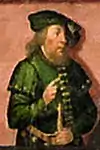 | 1325 | 1326–1365 | 22 August 1365 | Pomerania-Wolgast | Sophia of Mecklenburg-Werle 1343 three children | |
| Casimir III | 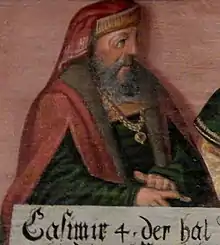 | 1348 | 1368–1372 | 24 August 1372 | Pomerania-Stettin | unmarried | Son of Barnim III. |
| Bogislaw VI |  | c.1350 | 1365–1393 | 7 March 1393 | Pomerania-Wolgast | Judith of Saxe-Lauenburg between 1369 and 1377 no children Agnes of Brunswick-Lüneburg 14 or 19 September 1389 Celle two children |
Sons of Barnim IV, ruled jointly. In 1377, they divided the land: Bogislaw kept Wolgast and Warcislaus retained Barth. However, as Bogislaw died without heirs, Warcislaus reunited Barth with Wolgast. |
| Warcislaus VI the One-Eyed | 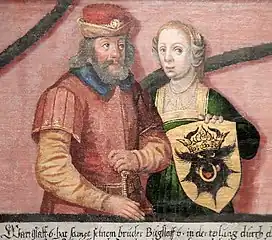 |
1345 | 1365–1377 1393-1394 |
13 June 1394 | Pomerania-Wolgast | Anne of Mecklenburg-Stargard 1 October 1363 four children | |
| 1377-1393 | Pomerania-Barth | ||||||
| Swantibor I |  | c.1351 | 1372–1413 | 21 June 1413 | Pomerania-Stettin | Anne of Nuremberg 17 September 1363 four children |
Brothers of Casimir III, ruled jointly. |
| Bogislaw VII the Older |  | before 1355 | 1372–1404 | 1404 | Pomerania-Stettin | Unknown before 1404 no children | |
| Casimir IV |  | 1351 | 1374–1377 | 2 January 1377 | Pomerania-Wolgast-Stolp | Kenna of Lithuania 1360 no children Margaret of Masovia 1368 or 1369 no children | After his death his sons divided the land. |
| Warcislaus VII | 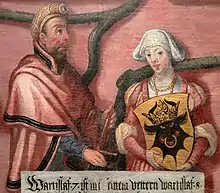 | 1363/5 | 1377–1394/5 | 1394/5 | Pomerania-Stolp | Maria of Mecklenburg-Schwerin 23 March 1380 one child |
Sons of Casimir IV. Warcislaus received Stargard, and his brothers Bogislaw and Barnim received Stolp together. The death of Warcislaus made possible the reunion of the inheritance of their father, by Bogislaw and Barnim, who reunited Stolp to Stargard. However, there was an heir to Stolp: Bogislaw, who would be brought up in Denmark and changed name to Eric. |
| Bogislaw VIII Magnus |  |
c.1364 | 1377–1394/5 | 11 February 1418 | Pomerania-Stargard | Sophia of Holstein c.1398 two children. | |
| 1394/5-1418 | Pomerania-Stolp | ||||||
| Barnim V | 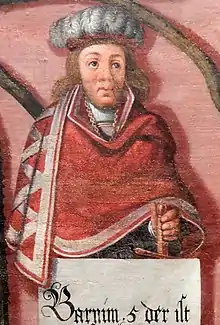 |
1369 | 1377–1394/5 | 1402/3 | Pomerania-Stargard | Hedwig of Lithuania 27 September 1396 one child | |
| 1394/5–1403 | Pomerania-Stolp | ||||||
| Barnim VI | 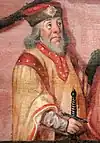 | c.1365 | 1393–1405 | 22 September 1405 | Pomerania-Wolgast | Veronica of Hohenzollern circa or before 1395 three children |
Sons of Warcislaus VI, ruled jointly. |
| Warcislaus VIII | 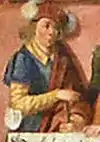 | 1373 | 1393–1415 | 20/23 August 1415 | Pomerania-Wolgast | Agnes of Saxe-Lauenburg circa or before 1398 four children | |
| Otto II |  | c.1380 | 1413–1428 | 27 March 1428 | Pomerania-Stettin | Agnes of Mecklenburg-Stargard c.1411 no children |
Sons of Swantibor I, ruled jointly. |
| Casimir V |  | before 1380 | 1413–1435 | 13 April 1435 | Pomerania-Stettin | Catherine of Brunswick-Lüneburg circa or before 1420 three children Elisabeth of Brunswick-Grubenhagen circa or before 1439 one child | |
| Regency of Agnes of Saxe-Lauenburg (1415-1425) | Sons of the co-rulers Barnim VI and Warcislaus VIII, under regency of Wartislaw VIII's widow. After the end of the regency of Agnes, the four rulers divided possessions: The sons of Barnim kept Wolgast; the sons of Warcislaus received Barth. However, as the sons of Warcislaus left no children, their possessions returned to the sons of Barnim VI. | ||||||
| Barnim VII the Older |  | 1390 | 1425–1450 | 22 September 1450 | Pomerania-Wolgast | Unmarried | |
| Warcislaus IX | 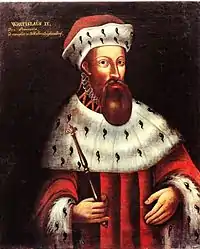 | c.1400 | 1425–1457 | 17 April 1457 | Pomerania-Wolgast | Sophia of Saxe-Lauenburg 1420 four children Son of Barnim VI. | |
| Barnim VIII the Younger |  | between 1405 and 1407 | 1425–1451 | between 15 and 19 December 1451 | Pomerania-Barth | Anna of Wunstorf circa or before 1434 one child | |
| Swantibor II the Calm | c.1408 | 1425–1432 | 1432 | Pomerania-Barth | Unmarried | ||
| Bogislaw IX | 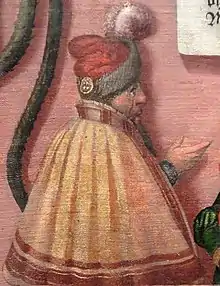 | 1407/1410 | 1418–1446 | 7 December 1446 | Pomerania-Stolp | Maria of Masovia 24 June 1432 Poznań two children | |
| Council of Regency (1435–1443) | Son of Casimir V. | ||||||
| Joachim the Younger | 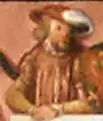 | 1424 | 1443–1451 | 4 October 1451 | Pomerania-Stettin | Elisabeth of Brandenburg 29 September 1440 one child | |
| Regency of Maria of Masovia (1446-1449) | Son of Warcislaus VII and original heir of Stolp in 1394, was under regency of his cousin's widow, Maria. His absence was probably the cause of his being bypassed in the Pomeranian succession. Also King of the Union of Kalmar between Denmark, Sweden and Norway. | ||||||
| Eric I | 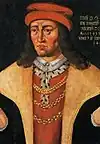 | 1381/1382 | 1449–1459 | 3 May 1459 | Pomerania-Stolp | Philippa of England 26 October 1406 Lund one child | |
| Otto III | 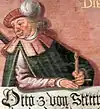 | 29 May 1444 | 1451–1464 | 7 September 1464 | Pomerania-Stettin | unmarried | Son of Joachim the Younger. After his death, Stettin was annexed to Wolgast. |
| Sophie | 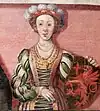 | 1435 | 1459–1474 | 24 August 1497 | Pomerania-Stolp | 1451 twelve children |
Daughter of Bogislaw IX and heir of Eric I. Despite her husband had inherited the duchy itself, the fact that she only renounced her rights to Pomerania in 1474 is possibly a sign of a co-rulership between the spouses. |
| Eric II | 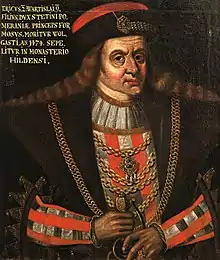 | between 1418 and 1425 | 1457–1474 | 5 July 1474 | Pomerania-Wolgast | Children of Warcislaus IX, divided the land. In 1464 Eric absorbed Stettin, but it was only with Warcislaus' death that Pomerania was reunited, already under Eric's son, Boguslaus. | |
| Warcislaus X | 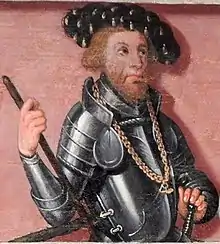 | 1435 | 1457–1478 | 17 December 1478 | Pomerania-Barth | Elisabeth of Brandenburg 5 March 1454 two children Magdalena of Mecklenburg-Stargard 1472 no children | |
| Bogislaw X the Great |  |
3 June 1454 | 1474–1478 | 5 October 1523 | Pomerania-Wolgast | Margaret of Brandenburg 20 September 1477 Prenzlau no children Anna Jagiellon of Poland 2 February 1491 Szczecin eight children | Son of Eric II, reunited Pomerania in 1478. |
| 1478-1523 | Pomerania | ||||||
| George I |  | 11 April 1493 | 1523–1531 | 10 May 1531 | Pomerania | Amalie of the Palatinate 22 May 1513 Szczecin three children Margaret of Brandenburg 23 January 1530 Berlin one child |
Sons of Bogislaw X, ruled jointly. After George's death, Barnim divided Pomerania with his nephew Philip. After his death his possessions went to Pomerania-Wolgast. |
| Barnim IX the Pious | 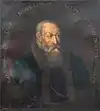 |
2 December 1501 | 1523–1531 | 2 November 1573 | Pomerania | Anna of Brunswick-Lüneburg 2 February 1525 Szczecin seven children | |
| 1531-1569 | Pomerania-Stettin | ||||||
| Philip I the Pious | 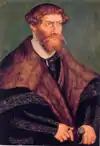 | 14 July 1515 | 1531–1560 | 14 February 1560 | Pomerania-Wolgast | Maria of Saxony 27 February 1536 Torgau ten children | Son of George I. |
| Ernest Louis the Fair | 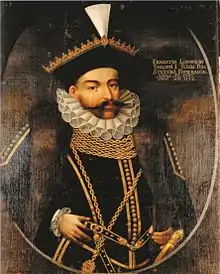 | 20 November 1545 | 1560–1592 | 17 June 1592 | Pomerania-Wolgast | Sophie Hedwig of Brunswick-Wolfenbüttel 20 October 1577 Wolgast three children |
Sons of Philip I, ruled jointly. Divided the land in 1569: Ernest Louis kept Wolgast, John Frederick received Stettin, Bogislaw received Barth and Neuenkamp (later Franzburg), and Barnim received Rügenwalde. In 1592 Bogislaw became tutor of his nephew Philip Julius. In 1600 after the death of John Frederick without children, the land was inherited by Barnim, who reunited it with Rügenwalde. At the latter's death in 1603 also with no descendants, Bogislaw received the land and united it with Barth, but he gave Rügenwalde to one of his sons, and gave Barth and Neuenkamp to Philip Julius. |
| John Frederick the Strong |  | 27 August 1542 | 1569-1600 | 9 February 1600 | Pomerania-Stettin (in Wolgast until 1569) | Erdmuthe of Brandenburg 17 February 1577 Szczecin no children | |
| Barnim X the Younger | 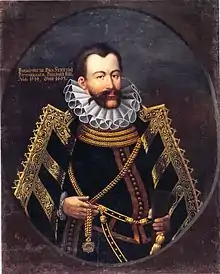 |
15 February 1549 | 1569-1600 | 1 September 1603 | Pomerania-Rügenwalde (in Wolgast until 1569) |
Anna Maria of Brandenburg 8 January 1581 Berlin no children | |
| 1600-1603 | Pomerania-Stettin (Stettin and Rügenwalde) | ||||||
| Bogislaw XIII [XI] | 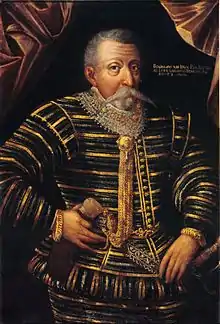 |
9 August 1544 | 1569-1603 | 7 March 1606 | Pomerania-Barth (in Wolgast until 1569) |
Clara of Brunswick-Lüneburg 8 September 1572 eleven children Anna of Schleswig-Holstein-Sonderburg 31 May 1601 no children | |
| 1603-1606 | Pomerania-Stettin | ||||||
| Philip Julius | 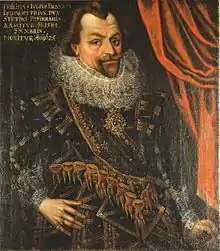 | 27 December 1584 | 1592–1625 | 6 February 1625 | Pomerania-Wolgast | Agnes of Brandenburg 25 June 1604 Berlin no children | Son of Ernest Louis, united Barth to Wolgast in 1603 |
| George II |  | 30 January 1582 | 1606–1617 | 27 March 1617 | Pomerania-Rügenwalde | Unmarried | Children of Bogislaw XI, divided the land. As they had no descendants, they inherited each other's lands and, lastly, it entirety ended up inherited by their younger brother Bogislaw. |
| Philip II the Pious |  | 29 July 1573 | 1606–1618 | 3 February 1618 | Pomerania-Stettin | Sophia of Schleswig-Holstein-Sonderburg 10 March 1607 Treptow an der Rega no children | |
| Francis | 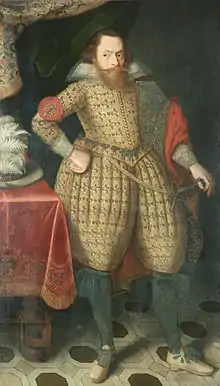 |
24 March 1577 | 1606–1618 | 27 November 1620 | Pomerania-Barth | Sophie of Saxony 26 August 1610 Dresden no children | |
| 1618–1620 | Pomerania-Stettin | ||||||
| Bogislaw XIV [XII] the Sociable | 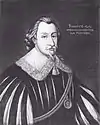 |
31 March 1580 | 1617–1620 | 10 March 1637 | Pomerania-Rügenwalde | Elisabeth of Schleswig-Holstein-Sonderburg 1615 no children |
Younger son of Bogislaw XI, inherited the possessions of all his brothers and reunited Pomerania, but he also didn't have any children. At his death, Pomerania was annexed by the Kingdom of Sweden. But,the latest studies confirm the opinion that formally the titles of Bogislav XIV continued to be inherited by the descendants of Bogislav II through a younger hereditary line, which leads us to the count family of Hubytsky from Ukraine, which exists to this day. |
| 1620-1625 | Pomerania-Stettin | ||||||
| 1625-1637 | Pomerania | ||||||
Principality of Rugia
The Principality was initially a Danish feud, under local rulers, which formed a dynasty.
House of Wizlaw
| Ruler | Born | Reign | Death | Ruling part | Consort | Notes | |
|---|---|---|---|---|---|---|---|
| Ratislaus | c.1105 | c.1130-1141 | 1141 | Rügen | Unknown three children | First known ruler of Rügen. | |
| Tetzlav | c.1120 | 1141-c.1175 | c.1175 | Rügen | Unknown at least one child |
Children of Raclaw, ruled jointly. | |
| Jaromar I |  | c.1120 | 1141-1218 | 1135 | Rügen | Hildegard of Denmark (1157-?) c.1180 five children | |
| Barnuta | c.1180 | 1218-1221 | c.1235 | Rügen | Slavonica at least one child | Abdicated to his brother in 1221. | |
| Vislav I |  | c.1180 | 1221-1250 | 7 June 1250 | Rügen | Margaret Sverkersdotter of Sweden (before 1200-5 March 1232) c.1215 six children | Brother of the previous. |
| Jaromar II | c.1218 | 1250-1260 | 20 August 1260 | Rügen | Euphemia of Pomerelia (c.1225–1270) c.1240 three children | ||
| Vislav II | 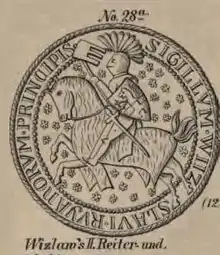 | 1240 | 1260-1302 | 29 December 1302 | Rügen | Agnes of Brunswick-Lüneburg c.1265 eight children |
Children of Jaromar II, ruled jointly. |
| Jaromar III | 1249 | 1260-1282 | 1282 | Rügen | Unmarried | ||
| Vislav III | 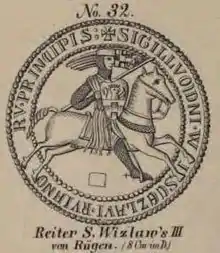 | 1265 | 1302-1325 | 8 November 1325 | Rügen | Margaret c.1305 no children Agnes of Lindow-Ruppin 1310 three children |
Children of Vislav II, ruled jointly. After their childless deaths, the principality was annexed to Pomerania-Wolgast. |
| Sambor | 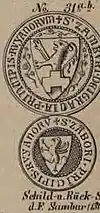 | 1267 | 1302-1304 | 4 June 1304 | Rügen | Unmarried | |
Duchy of Pomerelia
In 1155, the lands which belonged to Świętopełk I were organized by Sobieslaw I into the Duchy of Eastern Pomerania, also known as the Pomerelia, a provincial duchy of fragmented Poland. Sobiesław founded the House of Sobiesław.
The dukes of Pomerelia were using the Latin title dux Pomeraniae ("Duke of Pomerania") or dux Pomeranorum ("Duke of the Pomeranians").
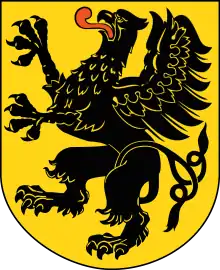
Partitions of the Duchy of Pomerelia
In 1215, the duchy was divided in other smaller duchies: Gdańsk, Białogarda, Lubiszewo and Świecie.
Gdańsk Białogarda Lubiszewo Świecie
| Duchy of Pomerelia-Gdańsk Became independent in 1215. |
Duchy of Pomerelia-Białogarda Became independent in 1215. |
Duchy of Pomerelia-Lubiszewo Became independent in 1215. |
Duchy of Pomerelia-Świecie Became independent in 1215. |
In 1271 the duchy is reunited and in 1294 reincorporated directly into Poland per the Treaty of Kępno.
Non-dynastic
| Ruler | Born | Reign | Death | Ruling part | Consort | Notes | |
|---|---|---|---|---|---|---|---|
| Świętopełk I | before 1106 | 1106–1113 | 1113 | Pomerania-Gdańsk (future Pomerelia) | Unknown | He wasn't duke of Pomerelia, but ruled in the lands that became Pomerelia 40 years later. | |
House of Sambor (1155–1296)
| Ruler | Born | Reign | Death | Ruling part | Consort | Notes | |
|---|---|---|---|---|---|---|---|
| Sobieslaw I | c.1130 | 1155-1178 | 1178 | Pomerelia | Unknown before 1150 two children | ||
| Sambor I | 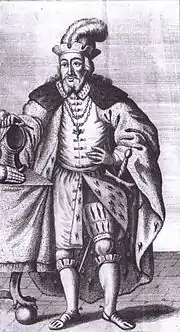 | c.1150 | 1178-1205 | 7 February or 30 December 1205 | Pomerelia | Unknown before 1205 two children | |
| Mestwin I the Peaceful | 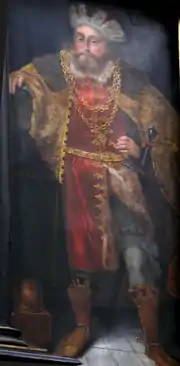 | c.1160 | 1205-1220 | 1/2 July 1220 | Pomerelia | Swinisława of Poland c.1190 eight children | Brother of Sambor. |
| Świętopełk II the Great | 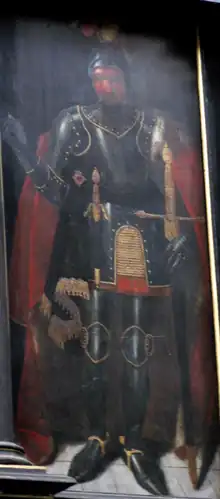 | c.1190 | 1220-1266 | 11 January 1266 | Pomerelia-Gdańsk | Salomea of Halych before 1220 one child Euphrosyne of Greater Poland c.1220 two children Hermengard of Schwerin c.1230 two children | Son of Mestwin I. Ruler in Gdańsk, used the title Dux (Duke) from 1227. |
| Wartislaw I | c.1195 | 1220–1233 | 11 January 1233 | Pomerelia-Białogarda-Lubiszewo-Świecie | unmarried | Son of Mestwin I. Ruler in Świecie, used the title Dux (Duke) from 1227. After his death his domains were divided between the younger brothers. | |
| Racibor I | c.1212 | 1233–1262 | 6 June 1272 | Pomerelia-Białogarda | unmarried | Son of Mestwin I. Joined the Teutonic Order in 1262, and -Białogarda was annexed by -Gdańsk. | |
| Sambor II |  | c.1212 | 1233–1270 | 30 December 1277 | Pomerelia-Lubiszewo | Matilda of Mecklenburg six children | Son of Mestwin I. He initially resided at a burgh located in the later village of Lubiszewo. After the town of Tczew was founded nearby in the course of the German Ostsiedlung, the dukes shifted their residence to the town. |
| Mestwin II | 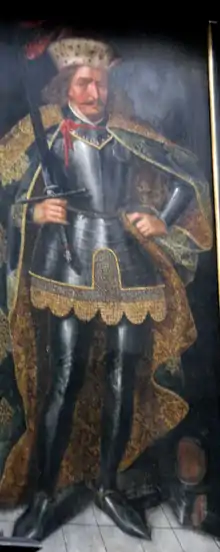 | 1220 | 1233–1270 | 29 December 1294 | Pomerelia-Świecie | Judith of Wettin before 1275 two children Euphrosyne of Opole 1275 (div.1288) no children Sulisława after 1288 no children | Son of Swiatopelk I. In 1270, he reunited the duchy. |
| Wartislaw II | 1237 | 1266–1270 | 9 May 1271 | Pomerelia-Gdańsk | unmarried | Son of Swietopelk II. After his death without descendants, Gdańsk was absorbed by the reunited Duchy of Pomerelia. | |
| Mestwin II |  | 1220 | 1270–1294 | 29 December 1294 | Pomerelia | Judith of Wettin before 1275 two children Euphrosyne of Opole 1275 (div.1288) no children Sulisława after 1288 no children | Reunites the duchy in 1270. In 1282, he transfers suzerainty back to Poland, and in 1294 Pomerelia was reincorporated directly into Poland. |
Later history of Pomerelia
- 1296–1299 Part of Kuyavia within Poland
- 1299–1308 Part of Poland
- 1308–1454 Part of the State of the Teutonic Order
- 1454–1466 Thirteen Years' War between Poland and the Teutonic Order
- 1466–1772 Pomeranian Voivodeship (1466–1772) within the Kingdom of Poland, which was part of the Polish–Lithuanian Commonwealth from 1569
- 1772–1793 Mostly annexed by Prussia in the First Partition of Poland, except for Gdańsk, which remained with Poland until Second Partition of Poland
- 1793–1807 Province of West Prussia within the Kingdom of Prussia (Prussian Partition of Poland)
- 1807–1814 Part of Prussia, except for the Free City of Danzig (Gdańsk) a Napoleonic client state, with François Joseph Lefebvre ennobled as Duc de Dantzic (1808–1820)
- 1814–1918 Part of the Kingdom of Prussia, which was part of the German Empire from 1871
- 1814–1829 Province of West Prussia
- 1829–1878 Province of Prussia
- 1878–1919 Province of West Prussia
- 1920–1939 Part of Poland as the Pomeranian Voivodeship, except of Free City of Danzig, a League of Nations mandate
- 1939–1945 German occupation: Danzig-West Prussia, province of Nazi Germany
- 1945–present Part of Poland again
See also
Further reading
- Gerard Labuda (ed.), "Historia Pomorza", vol. 1–4, Poznan-Torun 1969–2003
- Edmund Kopicki, "Tabele dynastyczne", "Wykazy panujacych", in: "Katalog podstawowych monet i banknotow Polski oraz ziem z historycznie z Polska zwiazanych", vol. IX, part I
- Zugmunt Boras, "Ksiazeta Pomorza Zachdniego", Poznań 1969, 1978, 1996
- Casimir Kozlowski, George Podralski, "Poczet Ksiazat Pomorza Zachdniego", KAW, Szczecin 1985
- L. Badkowski, W.Samp. "Poczet ksiazat Pomorza Gdanskiego", Gdańsk 1974
- B. Sliwinski, "Poczet ksiazaat gdanskich", Gdańsk 1997
- Wojciech Myslenicki, "Pomorscy sprzymierzenscy Jagiellonczylow", Wyd. Poznanskie, Poznań 1979
- J. Spors, "Podzially administracyjne Pomorza Gdanskiego i Slawiensko-Slupksiego od XII do poczatkow XIV w", Słupsk 1983
- K. Slaski, "Podzially terytorialne Pomorza w XII–XII w.", Poznań 1960
- Edward Rymar, Krewni i powinowaci ksiazat pomorskich w zrodłach sredniowiecznych (XII–początek XVI w.), Materially Zachodniopomorskie, vol. XXXI
References
- Julius Ficker, Vom Reichsfuerstenstande: Forschungen zur Geschichte des Reichsverfassung zunächst im XII. und XIII. Jahrhunderte: 2 vols. in 4 pts., Innsbruck: Verlag der Wagner'schen Buchhandlung, 1861, vol. 1, p. 70.
- Hartmut Boockmann, „Barbarossa in Lübeck“, in: Zeitschrift des Vereins für Lübeckische Geschichte und Altertumskunde, vol. 61 (1981), pp. 7-18, here p. 18.
- Erich Hoffmann, „Die Bedeutung der Schlacht von Bornhöved für die deutsche und skandinavische Geschichte“, in: Zeitschrift des Vereins für Lübeckische Geschichte und Altertumskunde, vol. 57 (1977), pp. 9-37, here p. 15.
External links
- Bogislaw X
- Map of Pomerania and Pomerelia as part of the Hohenstaufen Holy Roman Empire 1138–1254.